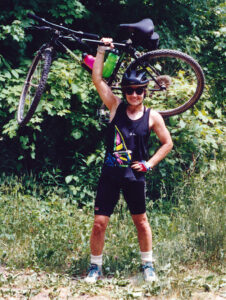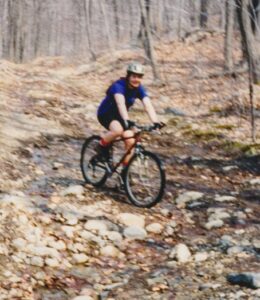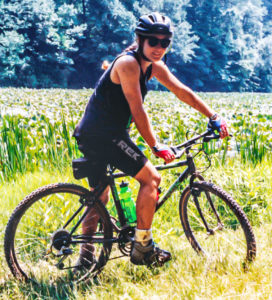 Pedaling my tiny two-wheeler in circles around a tree in my urban backyard, I dreamed of a bike made for mud. When the skinny tires got caught in a rut, my 7-year-old mind didn’t understand why a bike couldn’t just ride through it.
Pedaling my tiny two-wheeler in circles around a tree in my urban backyard, I dreamed of a bike made for mud. When the skinny tires got caught in a rut, my 7-year-old mind didn’t understand why a bike couldn’t just ride through it.
From the moment I got my first tricycle as a toddler, I was hooked on bikes. Little did I know, bikes would teach me valuable life lessons. After the tricycle, I grew into a Schwinn Pixie, the one I rode around the tree like a merry-go-round. I soon sprouted into a Schwinn Stingray and then a Schwinn Varsity 10 speed road bike with drop handlebars. Then something terrible happened. In my late teens, I parked my bike in the garage and there it sat for years. I’d moved on to other things until a friend from my ju-jitsu class asked me to go biking with him.
I rolled the bike out of the garage and hosed it down, blowing off the cobwebs, and pumped air into the flat tires. On our first ride, I noticed the gears weren’t shifting, so I brought it to a local bike shop, where I was told it wasn’t worth repairing. The bike shop owner introduced me to a new kind of bike that had come on the market during my hiatus from riding – the mountain bike! I couldn’t believe it! The bike I had always dreamed of had been invented!
There was nothing to question. I immediately plunked down over $800 on the black and neon green speckled Trek 7000. The bike was fully rigid with no shocks whatsoever. As instructed, I let out some air pressure from the tires and headed for the rocky trails of northern New Jersey, along with my friend, who was also pedaling a newly purchased mountain bike.
I believed in that bike. I believed it could do anything, go anywhere, and ride over everything, and so we did! With my feet clamped in toe clips, we tackled the tough terrain of Ringwood State Park on a regular basis, riding up steep inclines and zipping down the other side, kicking up small rocks that pinged against the aluminum frame. We pedaled through rock gardens and deep muddy puddles the size of small ponds. Covered in mud, there was nothing we couldn’t do, no place we couldn’t go.
I pedaled without fear, confident in my knobby-wheeled steed. Approaching obstacles, I cranked harder, anticipating only success. Bike and body worked in a finely tuned synchronicity. If my first try failed, I eagerly tried again until surmounting the hurdle. As the bike reacted to the terrain, I reacted to the bike to maintain balance. We were a team! This isn’t to say there weren’t mishaps. My body hit the dirt quite a few times. Racing along a leaf-covered trail in the autumn, the concealed ground below went from hard-packed dirt to loose gravel as I rounded a bend. The rear wheel slid out, dropping the bike out from under me. The momentum sent my body over the bars, soaring through the air Superman-style until gravity took over, landing me with a belly flop on the rocks. Dusting myself off, I walked back to my bike lying on its side with the rear wheel still spinning, picked it up, and pedaled on, announcing to my riding partner, “You haven’t been mountain biking until you’ve become part of the mountain”!
Sometimes my expectations defied the natural laws of physics, such as when I tried to ride up the equivalent of a dirt half pipe, created by Mother Nature, herself. From a running start, I was determined to reach the top. My last attempt sent me inches from the summit, where I became the victim of gravity. The bike stalled, flopping on its side. I landed face down alongside. Tightly grasping the frame with one hand, I dug my other hand in the dirt, and slid on my belly back down to the bottom. The friction tore a massive hole in my bike glove, the only causality of the day.
Mountain bikes continued evolving but I was always one step behind. When the Trek 7000 had seen its better days after 6 years of hard riding, I still believed it was good enough. However, the needed repairs cost more than the bike’s worth, so I upgraded to the newest technology – a bike with a front shock. I was told by the bike salesman that the front shock would allow me to ride over anything. I acknowledge the possibility but also still had faith that my old Trek could do just a good of a job. In lieu of an unnecessary diamond ring that would sit in a dark, closed jewelry box, my husband-to-be bought me a shiny red Kona Explosif with a Marzocchi front shock as a wedding gift.
I loved that bike, although I experienced some of my more spectacular crashes on it. The aggressive geometry was a human rocket launcher. Perched up high with no dropper post and with my body stretched forward, it was the perfect position to turn you into a projectile. A dropper post is a seat post that goes up and down to desired heights and is operated by a lever on the handlebars. I’d have to wait a while longer until benefitting from one.
During that time, the full suspension bike, with shocks in the front and rear had emerged and was all the latest rage. I purchased a Giant NRS 1 with a carbon fiber frame and Fox Racing shocks in the front and rear. We pedaled on for a few years but then something terrible happened – again. Except for riding on local roads from time to time, life, once again, got in the way and mountain biking was no longer on our agenda.
A few years ago, like I once did with old Schwinn Varsity, I hosed off the cobwebs and put new platform pedals on the Giant and started riding around a nearby lake. Next up was a return to Ringwood, where I cautiously navigated the trails. By this time, mountain bikes were totally redesigned, and I found myself scouring the Internet for a new bike. During the Ringwood ride, my husband’s front brake rotor blew out, giving me the perfect excuse to go to the bike shop.
It was love at first sight. I went numb when I first laid eyes on the Trek Fuel EX 8 in sparkling metallic red. Heftier, slacker, and with bigger, wider 29 inch wheels, the geometry sat you down in the cockpit more, and if you wanted to get lower on the descents, a flick of a lever sent the dropper post down. I knew this bike was mine.
 The salespeople at the bike shop, all avid mountain bikers quite a few years younger than me, couldn’t believe I had ridden the old Giant with it’s much thinner 26-inch wheels through rocky Ringwood. Aghast, one commented, “That’s nuts”! Perplexed, I responded, “Why? I rode Ringwood on a fully rigid bike for years – and did just fine.” Three sets of eyes just stared at me.
The salespeople at the bike shop, all avid mountain bikers quite a few years younger than me, couldn’t believe I had ridden the old Giant with it’s much thinner 26-inch wheels through rocky Ringwood. Aghast, one commented, “That’s nuts”! Perplexed, I responded, “Why? I rode Ringwood on a fully rigid bike for years – and did just fine.” Three sets of eyes just stared at me.
Finally up to date with the current bike technology, I enjoyed the cushioned ride over rocks, roots, and ruts. Unlike my first Trek, this new bike absorbed much of what the earth was throwing at it. In a way, it was like you were going along for the ride. The new geometry that didn’t position me to sail over the handlebars was an added plus.
I was back in the saddle and loving it. Our schedules don’t always allow for time to travel to rugged trails, so I wanted a bike to do speed and endurance training on locally. For that purpose, I bought a Trek X Caliber 9 hardtail with only a front shock, and immediate felt the old familiar kick when the back wheel was thrown by something in the terrain. My muscle memory was awakened and my body began reacting to the bike again.
Faster, more nimble, and livelier, the hardtail was more like my very first bike, where synchronicity of bike and body were essential. I began reflecting upon that fully rigid Trek, realizing it taught me so much about life, not just mountain biking. Mainly, that your mindset is of prime importance. If you believe in yourself and keep trying, you can ride over the obstacles in life. Doubt holds you back. Sometimes modern conveniences making us too soft, stripping us of that fearless eagerness to tackle what lies ahead.
A bike without shocks reacts to the terrain and you must react to the bike in a way to maintain balance. Having balance in life keeps us upright and moving forward towards goals. It also creates oneness and harmony with our surroundings. When bouncing over rough trails, you learn to raise your tail off saddle, as to not have the shock waves resonate throughout your whole body – your legs, along with the bike, act as the shock absorbers. You learn to go with the flow in the most efficient, least jarring way.
The degree to which one reacts is also critical. If the bike teeters to the right and you lean too far to the left, you’ll lose balance and topple over. Navigating through life is a balancing act. Maintain calm and keep moving forward with confidence.
This might sound metaphorical, but it’s reality. The reality that an optimistic attitude combined with reacting appropriately to maintain balance, while altering your course when needed, makes life’s challenges surmountable. Most importantly, don’t stop riding. After all, when you stop pedaling, you lose momentum and stop the forward motion. Keep pedaling and believe you can do anything, go anywhere, and ride over everything, and you will.
There’s a lot that can be learned from an old bicycle.
It was life changing in so many ways.


